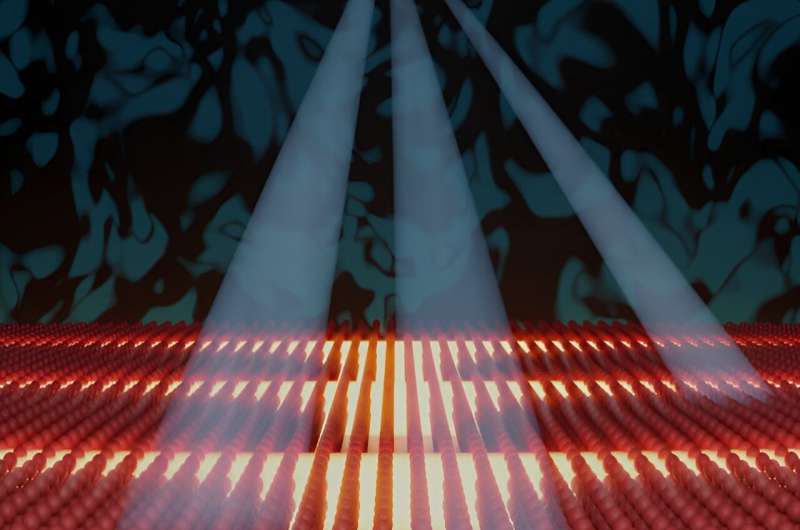This article has been reviewed according to Science X's editorial process and policies. Editors have highlighted the following attributes while ensuring the content's credibility:
fact-checked
peer-reviewed publication
trusted source
proofread
Spontaneous supercrystal discovered in switching metal-insulator

A supercrystal formation previously unobserved in a metal-insulating material was discovered by a Cornell-led research team, potentially unlocking new ways to engineer materials and devices with tunable electronic properties.
The researchers showed that the atomic structure in the thin-film Mott insulator Ca2RuO4—part of a unique family of materials that can switch between being a metal and an insulator due to quantum effects—forms an anisotropic, organized pattern with multiple spatial periods below temperatures of 200 to 250-degrees Kelvin. The spontaneous supercrystal formation was detailed June 17 in the journal Advanced Materials.
"This is a great example of complexity arising from simplicity," said Oleg Gorobtsov, postdoctoral fellow and lead author of the study.
"Usually, to create a supercrystal, you have to artificially engineer multiple layers of different materials on top of each other. Here is an example of how a relatively simple system demonstrates a very complex hierarchy of phase domains with different length scales."
The discovery is the result of an analysis technique developed by the research group of Andrej Singer, associate professor of materials science and engineering and senior author of the study. In 2023, Singer and others demonstrated how a combination of high-powered X-rays, phase-retrieval algorithms and machine learning can provide a real-space visualization of materials at the nanoscale.
This technique revealed a new type of strain-induced nanopattern that spontaneously forms in Ca2RuO4 during cooling to cryogenic temperatures. By zooming out, the latest research showed that the 10-nanometer structure was embedded in a larger supercrystal.
"By leveraging the synergy between state-of-the-art synthesis and characterization of structural and electronic properties, we were able to show that the orientation of this larger structure dictates the electronic properties," Singer said. "This is essentially a switch that can control how electricity flows through, offering potential advancements in energy-efficient electronics."
The versatile control capabilities of Mott insulators make them ideal materials for various applications, including memory elements and optical switches. Switchable structures such as the supercrystal state in Ca2RuO4 could offer a powerful means of influencing the energy balance between competing ground states, according to Gorobtsov.
"We don't just get the switch between conductivity and non-conductivity, but we also get this switch in the preferential direction of the current," Gorobtsov said, "which gives us a new lever to control technologically-relevant properties, potentially not just in this material, but in others as well."
More information: Oleg Yu. Gorobtsov et al, Spontaneous Supercrystal Formation During a Strain‐Engineered Metal–Insulator Transition, Advanced Materials (2024). DOI: 10.1002/adma.202403873
Journal information: Advanced Materials
Provided by Cornell University





















